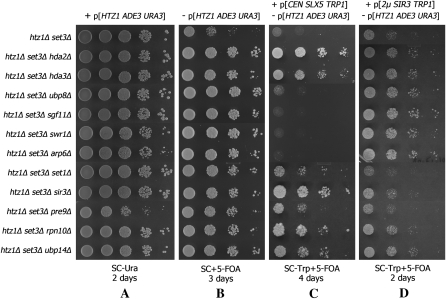Figure 1.—
Loss-of-function suppressors of the htz1Δ set3Δ synthetic slow-growth phenotype. (A) The indicated strains were cultured in SC–Ura media in the presence of pMSS59[HTZ1 ADE3 URA3]. Serial dilutions were plated on SC–Ura plates and grown for 2 days. (B) Small portions of the overnight cell cultures from A were resuspended in YPD and grown overnight to allow the segregational loss of pMSS59. Serial dilutions were plated on SC + 5-FOA plates and grown for 3 days. (C) Differential responses of suppressors to SLX5 overexpression. The indicated strains were transformed with pMH02[SLX5 TRP1] and the transformants were grown overnight in SC–Trp media to permit the loss of pMSS59 while maintaining pMH02. Serial dilutions of the overnight cultures were plated on SC–Trp + 5-FOA plates and grown for 4 days. (D) Differential responses of suppressors to SIR3 overexpression. The indicated strains were transformed with plasmid pMH10[2μ SIR3 TRP1] and the transformants were grown in SC–Trp media overnight to permit the loss of pMSS59 while maintaining pMH10. Serial dilutions of the overnight cultures were plated on SC–Trp + 5-FOA plates and grown for 2 days.

